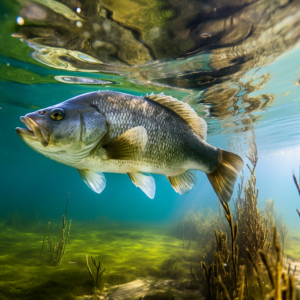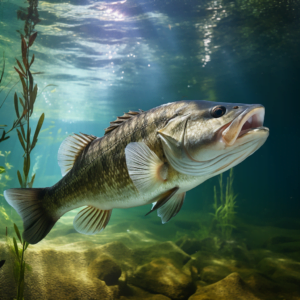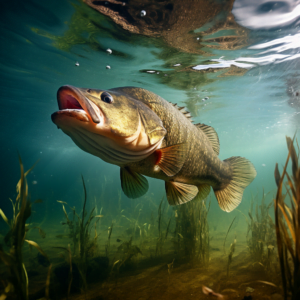So, you’re curious about what largemouth bass like to eat the most fishing? Well, let me tell you, these fish have quite the appetite! When it comes to their favorite food, they have a few top choices, and it’s important for any angler to know what they are. In this article, we’ll dive into the diet of largemouth bass and explore their preferred meals. By the end, you’ll have a better understanding of what bait to use when targeting these prized fish. Let’s get started!
Largemouth bass are known to be opportunistic feeders, meaning they will go after pretty much anything that looks like a tasty meal. However, there are a few key prey items that seem to be high on their list. One of their favorite foods is definitely smaller fish, such as minnows and shad. These provide a good source of protein and are commonly found in the same habitats as largemouth bass. So, if you’re looking to catch some bass, using live or artificial minnows can be a great choice.
Aside from fish, largemouth bass also have a fondness for insects and other aquatic creatures. They are particularly attracted to frogs, crayfish, and worms. These make up a significant part of their diet, especially during certain times of the year. So, if you’re not having much luck with fish as bait, you might want to try using lures or bait that imitates these critters. It could just be the trick to enticing a big bass to bite.
Now that you have a better idea of what largemouth bass like to snack on, you can adjust your fishing techniques accordingly. Remember, these fish are always on the hunt for a tasty meal, so it’s important to choose bait that mimics their favorite food. Whether you go for minnows, insects, or other prey items, understanding their feeding habits and preferences will greatly increase your chances of landing that prized largemouth bass. So, stay tuned for our next article, where we’ll delve even deeper into the world of bass fishing. Happy angling!
Largemouth Bass Diet
When it comes to the diet of largemouth bass, their feeding habits and food preferences play a crucial role. Understanding what they prefer to eat can significantly increase your chances of catching them. Factors such as natural prey, artificial baits, live baits, seasonal changes, hunting techniques, and environmental factors all influence their food choices.
Largemouth Bass Feeding Habits
Largemouth bass are opportunistic feeders, meaning they will eat almost anything that comes their way if it appears to be an easy meal. They are known to be voracious predators, often lurking in the shadows, patiently waiting for their next meal. Their feeding habits are primarily based on their energy requirements and the availability of food sources in their habitat.
Largemouth Bass Food Preferences
While largemouth bass have a varied diet, there are specific types of prey that they prefer. Understanding their food preferences can give you an edge when targeting these bass. The following are some of their favorite food choices:
Natural Prey of Largemouth Bass
Small Fish
One of the primary food sources for largemouth bass is small fish. They have a keen eye for movement, and when they spot a smaller fish swimming by, they will often launch an aggressive attack. The most common types of small fish that they feed on include minnows, shad, sunfish, and perch. These fish provide a good source of protein for largemouth bass and help fuel their growth and energy requirements.
Crayfish
Crayfish are another favorite food choice for largemouth bass. These crustaceans are rich in nutrients and provide a valuable food source, particularly in areas where they are abundant. Largemouth bass are known to actively hunt crayfish and will often swim along the bottom to catch them. Crayfish offer a high protein content and are often a preferred meal during certain times of the year.
Insects
Insects also form a significant part of the largemouth bass diet. They have a wide variety of insects to choose from, including dragonflies, grasshoppers, and various aquatic insects. Largemouth bass often feed on insects that fall into the water, as well as those that are on the surface. During the warmer months, when insects are more plentiful, largemouth bass may focus more heavily on this food source.
Artificial Baits for Largemouth Bass
Anglers often rely on artificial baits to attract largemouth bass. These baits mimic the appearance and movement of natural prey, which can entice the bass to strike. Some of the most popular artificial baits for largemouth bass include:
Plastic Worms
Plastic worms are one of the most versatile and effective baits for catching largemouth bass. They come in various colors and sizes, allowing anglers to tailor their presentation to match the conditions and preferences of the fish. Plastic worms mimic the appearance of worms or small fish, making them irresistible to largemouth bass.
Jigs
Jigs are another popular choice among anglers targeting largemouth bass. These artificial baits consist of a weighted head and a skirt or trailer. When retrieved, jigs create a realistic swimming action, attracting the attention of bass. Jigs come in different colors and sizes, allowing anglers to match the hatch and increase their chances of success.
Spinnerbaits
Spinnerbaits are excellent lures for covering a large area quickly and enticing aggressive strikes from largemouth bass. They consist of a metal blade that spins as it moves through the water, creating vibrations and flash that attract the attention of bass. Spinnerbaits come in various sizes and colors, making them suitable for different fishing conditions.
Live Baits for Largemouth Bass
While artificial baits can be effective, live baits also have their place when targeting largemouth bass. These baits imitate the natural movement and scent of prey, which can trigger a feeding response in the bass. Some popular live baits for largemouth bass include:
Nightcrawlers
Nightcrawlers, also known as earthworms, are a classic live bait option for largemouth bass. They are readily available and can be used year-round. Nightcrawlers appeal to the bass’s sense of smell, and their natural squirming motion in the water makes them an enticing meal.
Shiners
Shiners are small fish that are commonly used as live bait for largemouth bass. They are particularly effective when targeting larger bass because they mimic the preferred prey of the fish. Shiners can be fished using a float or suspended under a bobber, allowing them to swim freely and attract the attention of hungry bass.
Crawfish
Crawfish, also known as crayfish or freshwater lobsters, are a natural prey of largemouth bass. Using live crawfish as bait can be incredibly effective, especially in areas where these crustaceans are plentiful. The natural movement and scent of live crawfish can trigger a predatory response from largemouth bass, enticing them to strike.

Seasonal Changes in Largemouth Bass Diet
The diet of largemouth bass can vary depending on the time of year. Understanding these seasonal changes can help you adapt your fishing tactics and improve your chances of success. Let’s take a closer look at the diet of largemouth bass during each season:
Spring Diet
In the spring, as the water temperature begins to warm up, largemouth bass become more active and feed more aggressively. During this time, their diet consists mainly of smaller fish, such as minnows and shad, as well as crayfish and insects. As the bass prepare for the spawning season, their energy requirements increase, making them more opportunistic feeders.
Summer Diet
During the summer months, largemouth bass continue to feed on smaller fish, but they also target larger prey. They actively pursue larger fish, such as sunfish and perch, as well as crayfish. The abundance of insects during this time also makes them a significant food source for largemouth bass.
Fall Diet
In the fall, as the water temperature begins to cool down, largemouth bass shift their focus to fattening up for the upcoming winter months. They feed heavily on smaller fish, particularly shad, as well as crayfish and insects. The availability of food decreases as the water temperature drops, making the feeding window crucial for successful angling.
Winter Diet
During the winter, largemouth bass become less active and their feeding habits slow down significantly. They rely on stored fat reserves and feed sporadically on small fish, such as minnows, and occasionally on insects and crayfish. It is important to adjust your fishing techniques during this time to present your bait slowly and enticingly.
Hunting Techniques of Largemouth Bass
Understanding the hunting techniques of largemouth bass can help you present your bait in a way that triggers a predatory response. Here are some common hunting techniques employed by largemouth bass:
Ambush Predation
Largemouth bass are known for their ambush predation technique. They lurk in or near structures, such as submerged logs, vegetation, or rocky areas, and wait for their prey to come within striking distance. When an unsuspecting fish or insect swims by, the bass swiftly attacks, engulfing the prey in its large mouth.
Stalking Prey
In some cases, largemouth bass will stalk their prey before launching an attack. They carefully maneuver through the water, following their target closely and waiting for the opportune moment to strike. Stalking allows the bass to get closer to their prey without alerting them, increasing the chances of a successful catch.
Chasing Prey
Largemouth bass are also capable of chasing down their prey. When they spot a fast-moving target, such as a smaller fish, they will initiate a high-speed pursuit. The bass uses its powerful tail to propel itself forward, closing in on its prey and striking with lightning speed. This hunting technique requires agility and precision on the part of the bass.
Fishing Tips for Largemouth Bass
To improve your chances of catching largemouth bass, consider the following fishing tips:
Match the Hatch
Observing the natural prey in the water and selecting baits that closely mimic their appearance and movement can be highly effective. By matching the hatch, you increase the likelihood of attracting largemouth bass.
Experiment with Different Baits
Largemouth bass can have varying preferences depending on factors such as water clarity, weather conditions, and the availability of natural prey. Experimenting with different baits, both artificial and live, can help you determine what the bass are feeding on and increase your chances of success.
Focus on Structure
Largemouth bass are often found in areas with submerged structures, such as fallen trees, weed beds, or rocks. Targeting these areas increases your chances of encountering bass, as they provide ample hiding spots for the fish. By casting near or into these structures, you can effectively present your bait to the bass.
Consider Water Temperature
Water temperature plays a significant role in the behavior and feeding patterns of largemouth bass. They are most active in water temperatures between 60 to 75 degrees Fahrenheit (15 to 24 degrees Celsius). By monitoring the water temperature, you can adjust your fishing techniques and bait selection accordingly.
Conservation of Largemouth Bass and Their Food Sources
Conservation efforts are essential to ensure the long-term survival of largemouth bass and their food sources. Here are some key steps that can be taken to protect these species:
Protecting Spawning Grounds
Preserving and protecting the spawning grounds of largemouth bass is crucial for maintaining healthy population levels. Implementing regulations that restrict fishing during the spawning season can help ensure the bass have a safe and undisturbed environment to reproduce.
Sustainable Fishing Practices
Using sustainable fishing practices, such as catch-and-release, can help maintain a healthy balance between angling and conservation. Releasing larger bass back into the water allows them to continue reproducing and contributes to maintaining the population of the species.
Preserving Natural Habitats
Protecting and preserving the natural habitats of largemouth bass is vital for their survival. This includes maintaining healthy aquatic vegetation, ensuring water quality is optimal, and preventing pollution and habitat destruction.
Impacts of Environmental Factors on Largemouth Bass Diet
Largemouth bass and their food sources can be significantly impacted by various environmental factors. Understanding these impacts is crucial for effective conservation. Here are some key factors to consider:
Water Quality
Poor water quality can negatively impact the availability and quality of prey for largemouth bass. Pollution, such as excessive nutrients, pesticides, and industrial waste, can harm the overall health of the ecosystem and reduce the abundance of natural food sources.
Availability of Prey
Environmental changes, such as habitat loss or invasive species, can directly impact the availability of prey for largemouth bass. Reduction in the abundance or disruption of the natural food chain can lead to changes in the bass’s diet and overall health.
Climate Change
Climate change can alter the distribution and abundance of prey species that largemouth bass rely on. Changes in water temperature, precipitation patterns, and extreme weather events can disrupt the delicate balance of ecosystems, ultimately impacting the bass’s food sources.
Conclusion
Largemouth bass have a diverse and adaptable diet, feeding on a variety of prey depending on availability and their specific habitat. Understanding their food preferences, seasonal changes, hunting techniques, and environmental factors can greatly enhance your fishing experience. By using the right baits, adapting your techniques, and practicing conservation, you can increase your chances of not only catching largemouth bass but also contributing to their long-term survival. So next time you head out to the water, keep in mind the favorite food of largemouth bass and get ready for an exciting angling adventure!




